Daycare: How to Plan a Music Program in 9 Steps
Daycare Director — Are you struggling to plan a music program for the three, four and five year-old children in your daycare? Is your head spinning from trying to make sense of what you have found in your Internet searches?
Here is a way to structure your search. Look for the following 9 kinds of activity songs. These are the things I do when writing our lesson plans at Musical Child, Early Learning through Music. I know from years of experience that these nine specific activities work with ages three to five.
GROUP 1 — Seated Play Songs
This is by far the largest group of children’s songs in the world. Almost every culture has play songs specifically for children to keep them amused and to train their coordination skills. Sometimes they are called nursery songs.
1. Social Conventions e.g. Hello Song. Before you sing hello to each child, ask her/him to choose an action for everyone to follow. That keeps all the children involved until their turn comes around. This is highly repetitive but strangely it works. It settles everyone in daycare into the idea that we are going to be singing for a while.
2. Body Percussion. These action packed games get the children feeling the strong driving beat of the song so that it’s a sensation in their bodies. Interactive songs, chants, and raps use actions such as patting the knees; clapping the hands; pounding the fists; and crossing each arm or hand across the body. This wires the left and right brain together therefore aiding coordination. This is necessary for a good day of learning.
3. Finger Plays. By choosing the right finger play, you can make a delightful moment in the child’s day. A child who knows how to perform a finger play can play alone, with another child or show a loving adult at any time of the day. It’s a gift for the child’s mind, body and social confidence. It can help them make new friends in daycare.
4. Memory Songs are about those things children just have to learn by heart – the sequence of the numbers both forwards and backwards; the days of the week; or song lyrics in a language other than English. This kind of memory training is an important aspect of brain growth and development. You even get bragging rights because memory songs are something to tell your daycare parents about in your daily chats.
GROUP 2 — Rhythm Instrument Songs
Rhythmic entrainment to a beat is universal in humans as you see even in your youngest children. They can’t help but wiggle when they hear highly rhythmic music. Children’s entertainment groups know about this phenomenon. But it’s more critical than entertainment. it’s important for coordinated movements like walking, running, balancing, swinging. And without a good sense of rhythm, children of seven and eight often struggle with their reading. You can provide your children with authentic instrument designed for them by experts. I suggest sleigh bells to rattle, finger cymbals with knobs to clink, pairs of castanets to click, clap sticks or claves to tap together, guiros to scrape, egg maracas to shake and drums to beat.
5. Rhythm Instrument Songs.
You need activities that tell the children when to use their rhythm instruments (sometimes known as “untuned percussion”) so you don’t end up with a lot of noise. You get noise when all the children play different instruments all at the same time OUCH! Noise hurts everybody’s ears and is particularly disruptive to children new to your daycare who suffer from “sensory overload.” I suggest you choose songs that engage the imagination. That way the children have a reason to concentrate on each of their rhythm instruments, for example, when you sing a farm animal song and their bells represent sheep. You should always allow time for play and exploration. After a short free play time, you can come in with suggestions for the children to play a particular instrument by following your signal.
GROUP 3 — Harmony Instrument Songs
6. Melody and Harmony Instrument Songs.
All the songs are melodies on earth were devised inside cultural groups who decided what was in and what was out. We call these rules scales, modes ragas and other non-English words. These patterns of notes please humans because they occur in nature and follows the laws of physics. The most prevalent ‘scales’ on the planet are pentatonic. We can easily provide very young children with pentatonic scales and also with Western music’s major and minor scales by leaving around small “tuned percussion” for them to explore. Look for xylophones (wooden), chime bars and glockenspiels (metallic) .
Simple Melody and Harmony Instrument Songs can be played on these instruments by the four and five year-olds. Once again you need to allow playtime and exploration well before you expect the child to follow your suggestions for playing particular notes. Most of the children in your daycare will not be at the intellectual level of being able to play the “right note at the right time” to come up with a known tune. In the early stages of engaging with tuned percussion, they simply are not ready, but they are great at improvisation.
It doesn’t matter if they play different notes to what you are singing. If you carefully choose simple, pentatonic (5 note) songs, the gentle sounds of children playing whatever notes they choose will sound beautiful and will give much pleasure. Try these notes — CDEGA. Over time, most children become more and more selective about the sequence of notes they choose to play. Particularly at age five, they may even be able to play the melody by reading and following letter name notation charts. It’s another form of decoding like reading a picture book.
Other melody and harmony instruments to try are melodicas, keyboards, kalimbas (thumb pianos), harmonicas, ukuleles, slide whistles, and outdoor installations such as marimbas and tubular bells.
GROUP 4 — Whole Body Movement Songs
7. Drama and Movement. In this group of activities we use props and/or actions to dramatise the lyrics. The children become physically and emotionally engaged. This allows them to deepen their understanding of the lyrics. Often, this is the kind of activity that children want to do again!
8. Games and Dances. These sociable movement activities are easily achievable and often quite wonderful. They work even better when you have help the children to hold hands and keep the circle in shape, or make sure that partner-dancing is working well. It is worth persisting with dancing with young children so that you can have the pleasure of witnessing the moment when two or more of them spontaneously dance together during free time.
GROUP 5 — Story Songs
9. Story Songs provide focus-time. They are rich parcels of language that develop vocabulary and prosody (the rhythm of the vocal patterns in a language). Stories in song-form also provide “narrative structure”. They give extra time for the children in your daycare to develop their awareness of people, time, event and place and the ways these elements interact to make a good story.
A Complete Preschool Music Program
So that’s it, nine different activities in 5 groupings to cover all the music learning your preschool children need during their time in your daycare. Supplement these 9 activities with some good classical and World music for movement and rest times and you are guaranteed to having a successful music program — and a successful day! If you want to save hundreds of hours of preparation, I invite you to find out more about the Complete Music Curriculum at Musical Child.
Praise from a Daycare Operator
Here’s what one of our Family Daycare clients says:
From Valeska Bezuidenhout, Child Care Educator – Private Operator
Adelaide, South Australia, Australia
“I have started lesson 5 and 6 now and the children love all the songs, especially Lil Liza Jane and the use of so many instruments and props and doing something different all the time. My children have nearly mastered the circle dances we are getting there, and they are enjoying them thoroughly too. Still haven`t bought the hobby horses yet scarves for the horses tails works well for now.” April 2014
Want Some Help Planning Daycare Music?
I wish you every success and would love to help you achieve great results.
Want to get links to our free stuff and socials? Here’s our Link Tree
Want to discuss your music program or staff training? Here’s how to contact us.
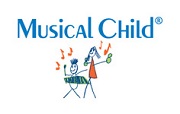
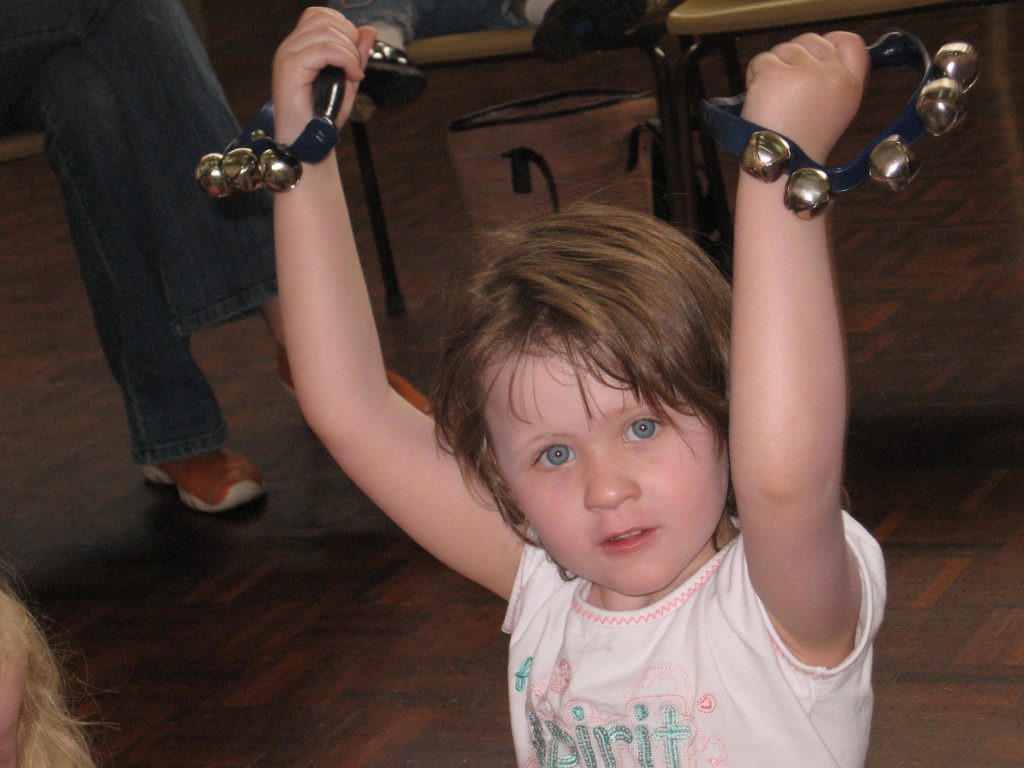
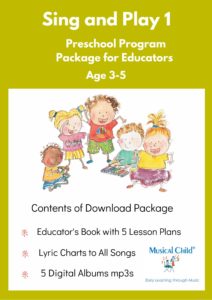

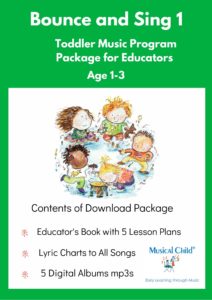
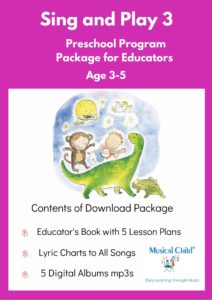
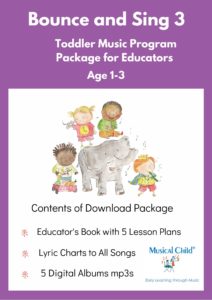
THANK YOU SO VERY MUCH.I HAVE BEING STRUGGLING WITH THIS FOR QUITE SOMETIME NOW.YOUR TIPS ARE VERY HELPFUL.I THINK I CAN FLY NOW!
Thank you very much Gibbowr. Searching online can be very confusing. I hope you are feeling confident enough to “fly solo”.
After I finish each session, I find that a short reflection on what worked and what went wrong can make the next session work better. I think we can teach ourselves, do you agree?